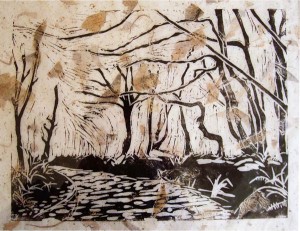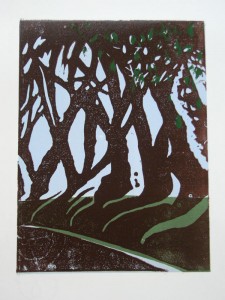Linocuts
Known as Relief Printing because the ink sits on the surface of the lino, ie on the parts that have not been cut away.
I love the simplicity of linocutting – again, I started using them because you can produce really interesting images without the need for a press. It is one of the printing methods people often tried at school, not particularly well, and then never looked at it again. (Bit like playing the recorder.) One thing to remember, what you dig out of your lino does not get printed which is easy to forget as you feel like you are drawing a line. A way to remind yourself at the beginning, is to paint the lino surface black, then when you cut into it you will get a paler line. The other thing is that it will print like a mirror image. Sometimes, if I want to check how my composition would look back to front then I scan the drawing into my computer and flip it.
If you are working without a press it is very important to chose your paper carefully – the thinner smoother papers are easier to manage when you are working with a burren or a wooden spoon. I have also experimented with some of the textured papers like mulberry, or seaweed which can add an extra dimension to your image. See below where the texture in the paper increases the effect of autumn winds blowing the trees about. If you are using a press then you can play around with thicker, and more textured papers.
My biggest challenge is always registering different colours when working by the reductive method; I think I am probably a bit impatient. However, I have just discovered the new soft lino – which you can cut easily with scissors. With this material you can cut blocks and print colours, then overprint. I have been looking at the work of Robert Tavener lately and trying to work out how he produced his images as he appears to have blocked colours in, then worked over the top. The soft lino will make that all much easier.
I have been trialling the soft lino: results below. Quite interesting I think because the first jigsaw print has the effect of a screen print; then a more detailed print over the top means you have a bit of background to back up or fight with your design which makes it a little less flat.
This needs a little more work, but as a broad principle, it gives some nice results. I am considering drawing another layer of finer detail on top, once it has all dried, but am not quite sure what medium to use as it has to work on top of the oil based ink. I put a few green leaves in with a small spatula, just using the printing ink on this one and haven’t decided if it works or not.
I took quite a lot of photos of trees in Cornwall this September because they grown into such interesting, twisty shapes; some of them feel quite fairytale, and Arthur Rackham! Because they are such strong shapes they lend themselves to being simplified for lino. I can feel a series coming on!


